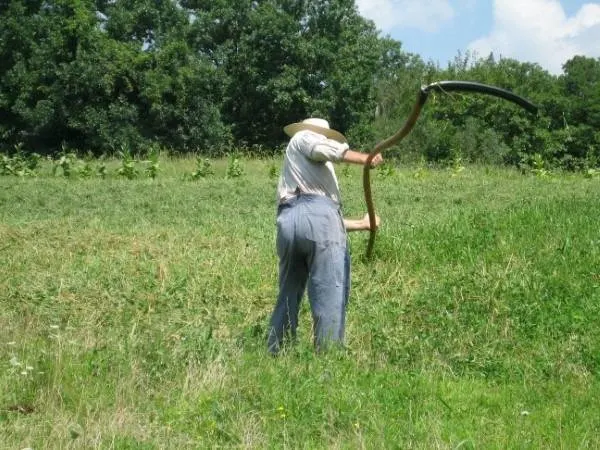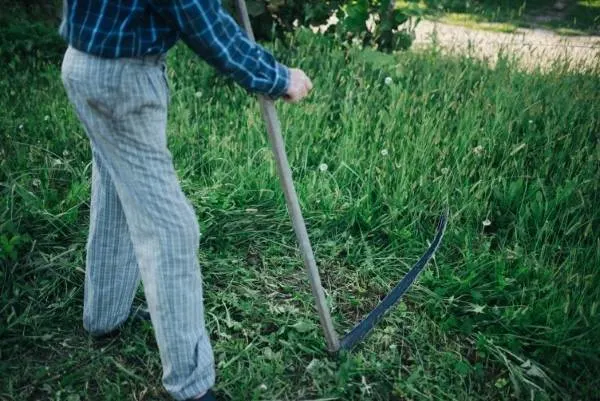Almost every small-scale farmer understood how to use a scythe until roughly a century ago. The scythe isn’t very groundbreaking. Small-scale farmers have used this agricultural wonder tool for millennia.
Most people knew how to get the most out of these hook-bladed devices, which cut hay, grain, and weed fields.
The scythe fell out of favor with the introduction of petroleum-powered harvesters and horse-drawn plows. Today, cutting crops and grass with reliable instruments was considered a charming folk craft.
However, survivalists have rediscovered the scythe in recent years. Many small-scale farmers and preppers discover how useful this centuries-old equipment is for homesteading and survival tasks.
Someone with a scythe may harvest an acre of hay or grain in a single day with a little elbow grease, cut weeds along hedgerows and in orchard plots, or even mow the front lawn if they’re particularly skilled!
This muscle-powered mower is a great cutter, but mastering it takes some practice and dedication. Keep reading the article to know how to use a scythe.
In this day and age of gas and electricity, it may seem strange to advocate a scythe as a practical instrument, but there are numerous reasons why this reaping tool has passed the test of time and is both practical and economically sensible.
It might be physically tiring if you don’t use a scythe correctly. If you start swinging your scythe around like wild, you could hurt yourself or your scythe. In a crisis, the last thing you need is to be on the defensive and fatigued.

How To Use A Scythe: A Guide To Reaping With A Scythe
- Before attempting to use a scythe, the first thing you need to do is learn the proper way to hold and position it. You should hold the scythe-like a person would hold a hammer.
- Take note of the blade. On the sharp edge, it’s practically as thin as paper, and it doesn’t get much thicker as it goes up. Horizontally, vertically, and along the edge, it has curves. The tension built into the steel, along with the curves, provides this exquisite blade with remarkable strength and resilience. However, even the greatest blade can be broken if used incorrectly. It’s critical to learn the proper stroke and maintain optimum blade condition.
- Never try to swing it as though it were a golf club. Swoop in a half-circle, rotating your whole trunk at the waistline and keeping the blade level with the ground so that the blade performs a slicing move rather than a chopping stroke. Doing a few practice swings is also good exercise and can be enjoyable.
- The end of the shaft you’re holding should go around your back, and you should grab onto it with both hands—one hand on each end, almost like an ‘okay’ sign. Now that you know how to handle the scythe, you are ready to use it.
- Just the tip of the blade must be in contact with the grass or sapling at the start of the swing. The stiff uncut grass will make it more difficult if you attempt to use the full edge of the scythe.
- The base of your blade stays on the ground throughout this action. The blade’s base is rounded to sweep the dirt and keep the sharp edge pointing in the appropriate direction to the grass. This means that as you mow, the ground bears the weight of the scythe; you aren’t lifting it off the ground. The blade is still pressed on the dirt on the return stroke.
- It’s ideal to begin slowly and gradually increase the force and velocity. The long-stroke relies on the strength of your thighs and buttocks. Direct the scythe’s path through the grass with your upper body, making sure only the blade’s tip moves.
- Keep your gaze fixed on the moving blade, ensuring that it remains near to the ground throughout the entire stroke. Your left hand should be behind you at the end of the exercise, and your weight should be on your left side. The blade should be pointing in the opposite direction. Your body spins and provides the power you need to complete the stroke. Take a small step forward before starting the following stroke.
- Start at the end of the row with less grass/weeds/grain on it if possible. Start with your non-dominant leg (if you’re right-handed, it means your left leg will be forward).
- Position yourself so that the scythe blade is past the top of your front foot and flat like the curve on a ‘C.’ Bring your blade behind you while pulling it back until it is past your non-dominant leg. Drag the scythe backward to cut through the grass/weeds/grain.
- When you bring back your scythe blade, make sure you aren’t bringing it down like an ax—this will make it hard to cut things, and you could accidentally hit yourself.
- Make sure your blade is flat like a ‘C’ and angled slightly upwards; this way, the scythe blade will not dig into the ground, making cutting difficult.

How To Use A Scythe: Care Tips
- When using this tool, you should be conscious of To avoid any accidents, make sure you have a firm footing on the ground.
- You do not want to be in a situation where you slip and fall while using a scythe—it’s a very dangerous instrument when it comes to causing injuries.
- If you’re going slow, be careful of anything in your path that may cause injuries—such as tree branches or the occasional rock in the ground.
- You should also make sure you know your surroundings when using this tool, as it can cause severe injuries if someone walks into it.
- You might want to consider wearing protective gear—you don’t want to end up accidentally impaling or slicing through your vital organs.
- Also, scythes tend to be sharp when in use. So, you might want to consider keeping it elevated off the ground, so it doesn’t accidentally cut through anything—including your feet!
- Short strokes are great if you’re trimming instead of mowing huge fields. You may easily trim around rocks, steps, fences, posts, plants, and foundations using short strokes.
- When trimming becomes more difficult, and it appears that the blade has lost its sharpness, come to a halt and sharpen it with a stone.
Final Remarks
You have just learned how to use a scythe properly—congratulations! Once you have learned these things, you are ready to start reaping with your scythe.
Be careful not to walk into it— as it could cause harm. Keep the blade angled slightly upwards to avoid digging into the ground, and have fun reaping! Learning this skill is very useful in a crisis, as it can give you access to food for yourself and your family.
The great thing about this scythe is that, unlike an electric one, you can transport it anywhere and start reaping immediately; there is no need to wait for it to charge up.
It’s a simple and humble tool that has been used as such since its origin as an agricultural instrument (and as an improvised weapon in the medieval period). Many people nowadays forget about this basic but effective tool, one that can be used as a reaper and as a weapon of self-defense.
